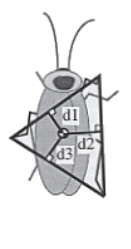Insects are able to walk through the contraction and relaxation of thoracic muscles attached to the leg base and to the cuticle. These muscles act firstly on the base of the leg, and the contraction is then transmitted through internal leg muscles through the leg, causing the leg to extend or flex (Cranston & Gullan, 2010).
Insects use mostly two gait types for walking, tripod gait and metachronal wave gait (Mushrush & Spirito, 1978). During tripod gait, three legs are in contact with the ground at all times, including the fore and hind legs of one side, and the mid leg of the other side. The rest of the legs swing forward, while the stable legs push the body forward and provide support (Cranston & Gullan, 2010). This mechanism of walking is called 'tripod gait', as the legs create a tripod shape (figure 2). This gait is very stable, as the insect's center of mass is always within the tripod.
Insects use mostly two gait types for walking, tripod gait and metachronal wave gait (Mushrush & Spirito, 1978). During tripod gait, three legs are in contact with the ground at all times, including the fore and hind legs of one side, and the mid leg of the other side. The rest of the legs swing forward, while the stable legs push the body forward and provide support (Cranston & Gullan, 2010). This mechanism of walking is called 'tripod gait', as the legs create a tripod shape (figure 2). This gait is very stable, as the insect's center of mass is always within the tripod.
Metachronal or wave gait involves moving only one leg at a time, starting at a hind leg on one side of the insect, then the mid leg on the same side, then the foreleg, then the same on the other side (Karalarli, 2003). This gait is slower than the tripod gait, but more stable, as there are more legs in contact with the ground during each leg movement.
Insects have a number of options they can use to enable them to move at higher speeds. They can:
Insects have a number of options they can use to enable them to move at higher speeds. They can:
- increase the frequency of leg movements
- increase their stride length
- raise two or four of their legs above the substrate and switch to quadrapedy or hind leg bipedality (Cranston & Gullan, 2010).
In all of these cases, the insect's centre of mass often falls outside the tripod, making it very unstable (Cranston & Gullan, 2010). The insect is no longer 'statically' stable, and must employ 'dynamic' stability techniques to ensure it does not lose balance (Ding et al, 2010). Dynamic stability involves using muscles to stay balanced.
Engineers have recently started using insect gait mechanisms in their robots, as they have found that like their biological counterparts, hexapod robots are very stable . These robots typically use the tripod gait, but can also use the metachornal wave gait and a number of other gait types not often seen in insects. These will be explored on the next page, types of robot gait.
Engineers have recently started using insect gait mechanisms in their robots, as they have found that like their biological counterparts, hexapod robots are very stable . These robots typically use the tripod gait, but can also use the metachornal wave gait and a number of other gait types not often seen in insects. These will be explored on the next page, types of robot gait.

